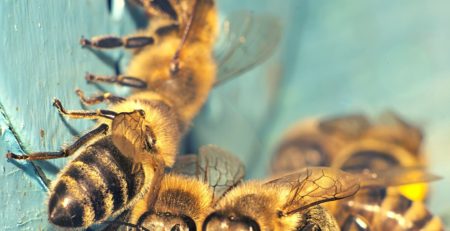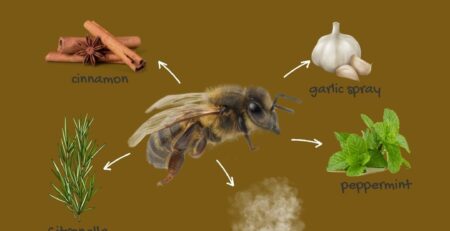Emergency Bee Removal: Dealing with Unexpected Winter Swarms and Bee Behavior
Winter in Orange County is more than just a chilly season; it’s a time when our local ecosystems undergo a fascinating transformation, thanks to the unsung heroes – honeybee colonies. In this guide, we’ll unravel the heartwarming secrets of how these tiny yet mighty creatures navigate the winter months, contributing to the vibrancy of our surroundings.
The Winter Behavior of Honeybee Colonies:
Picture this: a winter gathering inside the hive, where honeybees huddle together for warmth and unity. They’re not sleeping; they’re orchestrating a symphony of survival. By forming a cozy cluster around the queen, they generate heat and share the love – in this case, the honey reserves they’ve worked so hard to collect during the warmer months.
In the enchanting world of honeybees, communication is a dance – a dance of survival, resource sharing, and collective decision-making. Even in the depths of winter, when the outside world is cold and dark, the hive buzzes with a silent language that guides the colony through the challenges of the season.
1. The Dance of the Cold Months:
While the famous waggle dance is often associated with warmer seasons, bees have adapted their communication methods for winter. Instead of the energetic figure-eight pattern on the honeycomb, winter communication involves subtle vibrations and gentle movements.
2. Tactile Signaling:
In the confined space of the hive, where darkness prevails, bees resort to tactile signaling. They use gentle taps and vibrations to convey information. For example, a bee might signal the location of a vital food source by delicately tapping another bee or by vibrating its body in a specific manner.
3. Trophallaxis in the Winter Darkness:
Trophallaxis, the sharing of food among colony members, takes on a vital role in winter communication. Bees pass food between each other, not only as a nutritional exchange but also as a form of communication. The taste of certain substances can indicate the quality and location of available food sources.
4. Pheromones in the Chilled Air:
Pheromones, the chemical messengers of the insect world, play a crucial role in winter communication. Bees release specific pheromones to signal danger, mark pathways to food, or communicate the overall health of the colony. In the winter hive, where visual cues are limited, pheromones become the backbone of communication.
5. Collective Decision-Making:
Winter is a time when crucial decisions are made for the hive’s survival. Should the colony move to a new location within the hive for better insulation? Is it time to consume stored honey? Through a collective decision-making process, bees communicate their needs and respond to challenges, ensuring the hive’s resilience in the face of winter hardships.
6. Adaptations for Darkness:
Winter days are shorter, and the hive experiences longer periods of darkness. Bees have adapted by becoming more sensitive to light changes, using whatever ambient light is available. This heightened sensitivity allows them to coordinate activities even in the limited light conditions of winter.
7. Maintaining Warmth through Communication:
Communication in winter isn’t just about information; it’s also a tool for maintaining the hive’s temperature. Bees generate heat through metabolic processes, and the coordination of their movements helps distribute this warmth effectively, ensuring the survival of the colony through the chilly months.
In the intricate ballet of winter communication within a hive, bees showcase their incredible adaptability. By exploring these subtle yet sophisticated forms of communication, we gain a deeper appreciation for the resilience and teamwork that define the honeybee colony, even in the mild days of Orange County’s winter.
The Importance of Honey Reserves:
Honey isn’t just a sweet treat for us; it’s a lifeline for honeybees during winter. Stored in their hive like precious jars of sunshine, honey reserves become their main source of sustenance when foraging becomes a frosty challenge. Beyond nutrition, honey also acts as a winter blanket, insulating the hive and keeping the colony snug.
Winter Pollination:
Contrary to the winter dormancy stereotype, honeybees don’t take a break from their essential role as pollinators. Some plants, eager to show off their winter blooms, count on our buzzing friends to spread the pollen love. It’s a reminder that even in the quieter months, the dance of life continues, thanks to our diligent pollinators.
The Threat of Unexpected Winter Swarms:
As we marvel at the bees’ resilience and contributions, it’s crucial to address potential challenges that can arise, such as unexpected winter swarms. These swarming events, while fascinating, can pose risks and uncertainties, requiring beekeepers and residents alike to be well-prepared for emergency situations. Let’s explore how honeybee colonies contribute to the winter ecology of Orange County and delve into strategies for managing and responding to unexpected swarms, ensuring both the well-being of the bees and the safety of our communities.
Understanding Winter Swarming:
Winter swarms? Yes, they happen. When the hive gets a bit too crowded, a group of adventurous bees decides it’s time for a change of scenery. These unexpected winter swarms add a touch of drama to the season, demanding our attention and a bit of know-how.
Challenges Posed by Winter Swarms:
Dealing with winter swarms is like orchestrating a dance in the cold. It’s not easy. The Bee Man, our go-to bee removal wizards in Orange County, understands the complexities of these winter swarms. Their timely and professional Orange County bee removal services ensure a safe relocation for the bees and peace of mind for us.
Emergency Bee Removal in Orange County:
Swift Action for Winter Swarms:
When a surprise winter swarm buzzes into your life, you need swift and expert action. Enter The Bee Man, your trusted bee removal sidekick in Orange County. They specialize in emergency bee removal, turning potential chaos into a well-choreographed ballet, ensuring everyone’s safety and the bees’ well-being.
Professional Expertise for Winter Bee Removal:
The Bee Man’s team doesn’t just remove bees; they do it with heart and expertise. Handling winter swarms requires a special touch, and these professionals know how to navigate the cold and keep both residents and bees safe.
Conclusion:
As winter unfolds its chilly embrace in Orange County, let’s marvel at the tiny miracles happening in honeybee colonies. From their cozy cluster dances to unexpected winter swarms, these bees play a crucial role in keeping our environment thriving. And when things get a bit too buzzy, remember, The Bee Man is here to lend a helping hand. By understanding and appreciating our buzzing companions, we can make winter a season of harmony and coexistence with these essential pollinators.
See related blog here: https://beemanbuzz.com/understanding-bee-behavior-in-colder-months-a-guide-for-orange-county-residents/











